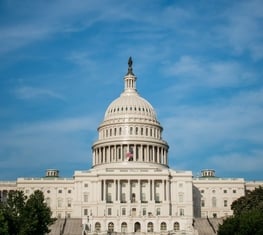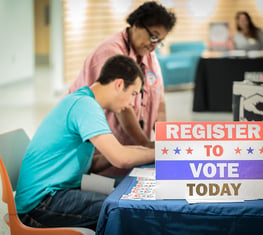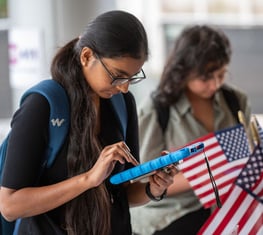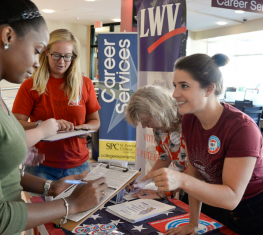This story was originally published in Bustle.
By ERIN DELMORE
When high school students took to the stage during last month's March For Our Lives in Washington, D.C., their signature chant, "vote them out," echoed across the National Mall — and throughout some 800 sister marches around the country. It marked the sixth week of public pressure by student activists to hold lawmakers accountable for what they say are failing gun policies that leave their schools vulnerable to deadly shooting sprees.
"I think conservative politicians should be really scared," 19-year-old Flo Joseph, a senior at Harvest Collegiate High School in New York City, told Bustle during her school's walkout in March.
Students like Joseph who organized rallies, marches, and walkouts in the weeks after a school shooting in Parkland, Florida left 17 dead are turning their attention to voter registration efforts ahead of this fall's midterm elections. How many first-time voters registered after Parkland could show just how powerful Generation Z really is — but while the movement wants to use its momentum to get protesters to the polls, there's no hard data yet showing it's generating a massive voter operation.
Legacy groups like Rock The Vote, the League of Women Voters, and HeadCount worked on voter registration efforts last month alongside organizers from the Women's March and the March For Our Lives. But many of these groups say they're unable to share hard numbers with Bustle because local partners hold the data on the number of people who actually registered.
"It is safe to say that we have never registered this many people, so early in the year, during a non-presidential election year."
Voter registration volunteers typically print out hundreds of forms and carry them around on clipboards or hand them out at tables. Sometimes volunteers will take back completed forms and mail them in. The nonpartisan organization HeadCount came to the conclusion that such traditional means of registering people to vote aren't very convenient for young people. They're used to filing paperwork online, working longer hours than generations past, and moving more frequently, which can mean they need to update their voter registration data more often.
"We don't have the time to go to the DMV between 9 and 5," Ghitelman tells Bustle. "[So] the idea is, how can we find young people where they are and make it easy for young people to vote."
HeadCount partnered with student organizers during March For Our Lives and helped register 5,071 people at events in 30 cities, including St. Louis, Salt Lake City, Boston, and Atlanta. Ghitelman says the largest share of those people, 1,552, registered at the main march in Washington.
"It is safe to say that we have never registered this many people, so early in the year, during a non-presidential election year," Ghitelman tells Bustle. "We certainly have registered a good deal more people by April 1st in 2018 than we had by this date in 2014," the last midterm election year.
The Youth branch of the Women’s March movement, called EMPOWER, worked with students to register voters at their schools during walkouts in February and March. A spokesperson told Bustle that during that time, 2,724 people took steps to fill out an application online. But only 1,226 of them — fewer than half — completed the process, which can include printing, signing, and mailing the registration forms, depending on which state the applicant lives in.
Teens Showed Up To Protest, But Will They Show Up To Vote?
The vast majority of America's sophomores, juniors, and seniors, or roughly 75 percent of current high school students, will be eligible to vote in the next presidential election. In 2024, their generation will account for one in 10 eligible voters, according to CNN. And according to a study by the Pew Research Center, nearly three-fifths of millennial voters, who are considered to be slightly older than current high school students, identify as Democrats.
In conversations with Bustle, high school students say gun control isn't the only issue that drives them to the Democratic Party. They cite gay and transgender rights, reproductive rights, and immigration, in particular the controversy over young undocumented people known as Dreamers, as issues on which they identify with Democrats.
The trend of young people leaning left was underway long before Parkland. Today's Democratic Party is younger, more diverse, and more educated than it was decades ago, in line with changing demographics and educational attainment in America itself. In 2017, 59 percent of Democratic-leaning voters identified as white; two decades earlier, 75 percent of Democratic-leaning voters had identified as such, according to the Pew Research Center. And 58 percent of college grads now affiliate with the Democratic Party, compared with 36 percent of them who lean toward the GOP.
While the generation currently in high school didn't make up the largest share of attendees at the March for Our Lives, they literally took center stage. All non-celebrity speakers at the Washington, D.C. rally were 18 or younger, showcasing political activism from an unlikely age group. Activist and partisan groups are looking to harness that enthusiasm ahead of the 2018 midterm elections.
At Harvest Collegiate High School in NYC, which partnered with adult "allies" from the Women's March to lead its walkout last month, students worked on organizing a voter registration drive geared toward seniors. They tell Bustle their aim is to make the day an annual event.
Meanwhile, the Women's March Coalition, a source of organizational strength for the student-led gun control movement, is embarking on a 10-state tour called Power to the Polls. The tour aims to encourage people to register to vote, and especially aims to assist people who don't realize they're eligible to vote or who need help registering.
Their goal is to register one million voters before the midterms. But it remains to be seen whether the Women's March can register people to vote in the same massivenumbers they turned out for the 2017 and 2018 Women's Marches and the D.C. March For Our Lives. Local marches held simultaneously with the mega-demonstration in D.C. reached more than 800 sites across the country in 387 congressional districts; that means a rally was held in nearly 90 percent of America's voting districts.
"The real power comes at the midterms," Tabitha St. Bernard-Jacobs, the Women's March Youth Director, tells Bustle. "The way to really respond to this is to vote out people that don't have your interests at heart. Vote out the people who do not really represent the concerns that matter to you."
A Thousand Miles North Of Parkland, High Schoolers Get Out The Vote
More than a thousand miles north of Parkland, Tim Binnig, a senior at Westerville Central High School in Westerville, Ohio, is leading his peers in taking action on gun reform and voter registration. He'll go to the polls himself for the first time in November.
"Hopefully there will be a good representation from my generation at the polls because in government class we learn that voter apathy and lethargic political activism is a very real and existent problem in our society," Binnig tells Bustle. "In addition to gun violence, we want to make our generation be basically one that can set the trend where we start to really be active citizens and participate in our government and make the democracy work."
Binnig expects gun control to be only one of a number of issues that drives young people to the polls, including the rising cost of college tuition, the availability of student loans, and various social issues that affect them personally. As residents of a swing state, Ohioans have a pivotal role in deciding the outcome of presidential elections. A "politiclub" at one of the high schools in the Westerville City School District is organizing voter registration efforts across the community, according to Binnig. He says student activists are also lobbying local representatives to come talk to students.
"We really just want to encourage discussion," Binnig says. "It doesn't necessarily have to be politically fueled discussion. We just want to talk about it and find resolutions that everyone can agree with, because when there's polarizing discussion, it's not necessarily helpful."
Students Find Strength In Numbers ... On Social Media
Teenagers may be criticized for being more comfortable talking through a smartphone than face-to-face, but student activists say social media is a source of their strength. During the Parkland shooting, students filmed what they feared were their last moments, and those viral videos reached young people previously undisturbed by school gun violence in America. Through Twitter, Facebook, Instagram and organizing spaces like Change.org, students have leveraged their own anger and grief to launch a unifying call for change.
"We're processing mass suffering on a level humans never have before, and we're pissed."
"An opinion from someone in Ohio might be different from someone who lives in Florida or California or anyone in the country or really the world," Binnig says. He credits social media with bringing the disparate groups together and expanding the number of issues young people care about.
Joseph says the experiences she's seeing other teens go through, whether on a screen or in person, are motivating her to go to the polls. More than 187,000 studentshave experienced a shooting that occurred on school property during the school day, according to the Washington Post. That means the number of kids affected is greater than the total population of Fort Lauderdale, Florida.
"They call us the Instagram generation, and they think that it's a bad thing, But really what it means is at the touch of my fingers, I can see videos of the kids lying on the floor in Parkland," Joseph says.
She says that flood of graphic images and videos, coupled with the constant news of school shootings, makes every student feel like a victim. Now, Joseph sees students channeling their grief, anxiety, and anger into calls to vote out the lawmakers they hold responsible.
"We're processing mass suffering on a level humans never have before," she says, "and we're pissed."




